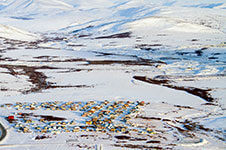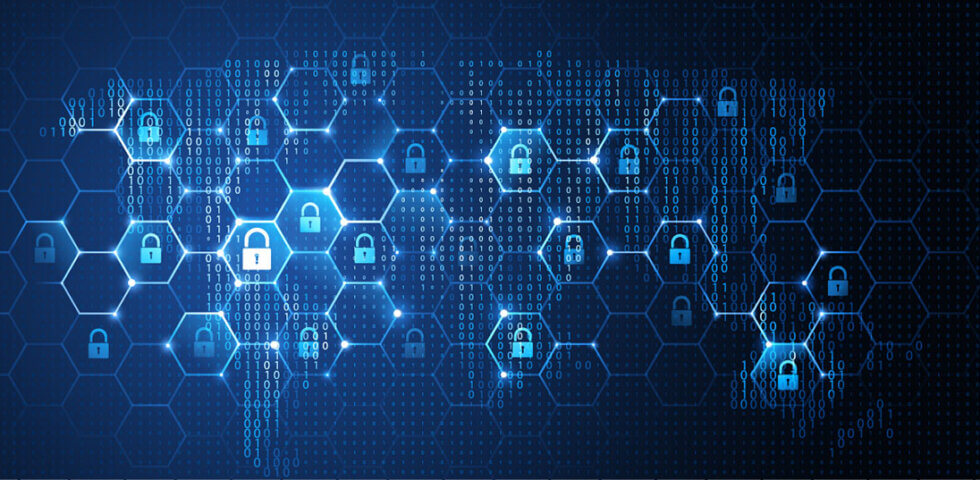At Quintillion, protecting our equipment and data is a priority. We handle critical infrastructure, such as subsea fiber optic cables that provide internet to thousands of Alaskans, as well as a satellite downlinking facility that harbors potentially sensitive data. Service interruptions, whether due to natural causes or malicious parties, can result in serious outcomes that threaten national security and even public safety. Therefore, Quintillion places the utmost importance on security.
Quintillion has gone through great measures to build infrastructure that is resilient to the harsh Alaska landscape in order to provide a layer of security that goes above and beyond to keep our customers’ data safe. For this blog, we spoke with Quintillion’s Chief Security Officer, Lance Dubsky, to provide some valuable insight into how we secure our infrastructure — from our fiber optic cable network and cable landing stations, to the High Latitude Data Acquisition (HiLDA) ground station.
Quintillion’s Critical Infrastructure: Why Network Security Is Essential
Quintillion’s Chief Security Officer, Lance Dubsky, is responsible for maintaining security for Quintillion’s infrastructure. This includes personnel, physical, network, and cyber security. With over 30 years of IT and Security experience in the military, public, and private sector, his background was ideal for delivering Quintillion’s network security.
“The past two years of the pandemic have taken a toll on families and businesses. Across America, many have suffered because of the isolation and limited access to information. When you live in the Arctic, you are already isolated, and communication can be a challenge.
Quintillion helps provide Alaskans the communications infrastructure and high-speed service needed to stay connected through voice and video with vital services like healthcare, education, and information. Wherever Quintillion is, Alaskans have the ability to communicate with doctors, teachers, businesses, and loved ones.”
Quintillion’s infrastructure provides crucial commercial communication in the North Slopes of Alaska and down the Dalton Highway. This fiber optic cable system has been providing the community with high-speed fiber connection since 2017, and the community has come to rely on this infrastructure for economic growth, communication, education, medicine, and much more.
Fortunately, since its launch in 2017, Quintillion’s service has not had any service interruptions or cybersecurity breaches. There are several dangers to subsea cables that can potentially damage lines and cause service interruptions, including fish trawlers, anchors, marine animals, or human adversaries. However, Quintillion’s robust system was strategically routed and designed to avoid these issues.
Quintillion’s Role in National Security
Quintillion’s US-owned fiber optic cable system and HiLDA ground station both play important roles in supporting the US government in the Arctic. Keeping this infrastructure secure ensures sensitive data is kept safe and delivered in a fast, reliable manner.
The Arctic is a competitive location for many of the world’s superpowers. The United States and its adversaries are focused on the Arctic as a new frontier on Earth, seeking opportunities to gain the upper hand in creating new shipping routes, acquiring the region’s many natural resources, and gaining strategic defense postures. With an increased military presence comes an increased need for communication and reliable service in the area.
In May of 2021, Quintillion signed a National Security Agreement with the US government. With this agreement, we embraced raising our protection standards and have met all of their requirements, including:
- Increased access control safeguards and personnel security screening
- Disaster recovery planning and testing
- Government network architecture and equipment review and approval
- Implementation of a policy framework based on the NIST Cybersecurity Framework

Quintillion’s Multi-Layered Security Approach
There are multiple layers of protection to Quintillion’s fiber optic cable system, cable landing stations, and ground station. This approach ensures we identify all possible vulnerabilities — whether they be physical or cyber — and deliver mitigation strategies to resolve identified risks. Here are a few of the steps we take to ensure our infrastructure is secure and operational.
- Subsea cable resilience: Our subsea cables are designed to withstand Arctic conditions and the undersea environment. The primary threat to fiber optic cables is natural factors, which is why we take extra precautions. Our cables are armored and buried up to 12 feet below the seabed.
- Data encryption: All the data that comes through our fiber optic cables are encrypted. This includes data that is downlinked from a satellite to our HiLDA ground station. This ensures the data is incomprehensible to anyone without the encryption key.
- Physical security: The cable landings stations are modular in design, are installed in steel conduits, and most include perimeter protection, gates, 24/7 video monitoring inside and out, and access control systems. Locked equipment cabinets provide an extra layer of security.
- Redundant Power: By utilizing multiple power sources, we help ensure the equipment stays operational regardless of equipment failure or weather issues. We utilize robust feeds with redundant power equipment at each landing site.
- Personnel Monitoring: As part of the National Security Agreement, we screen all personnel and limit access to only our team and vendors. This screening process includes full background investigations.
- Remote Stations: The location of Quintillion’s fiber optic cable system and ground station provide a natural advantage. Since our infrastructure is in the Alaskan Arctic, which is the most remote location in the United States, it is far from most human activity. The harsh landscape and arctic environment also make it hard to access. Many of the stations reside in the oil fields, which have their own security systems in place.
- Network Security: Our design approach is to build in security, to be strict on access control to the system, tightly manage ports, and oversee and monitor all changes. Quintillion also uses network segmentation.
HiLDA Ground Station Security
The HiLDA ground station has many of the same layers of security, including a resilient design with multiple power sources, monitored and protected systems, personnel monitoring, and encryption. Furthermore, the ground station is in Utqiaġvik in a remote, hard-to-access location on US soil.
In addition to the measures we’ve taken to secure our equipment, our ground station partners continue to adhere to this high standard of security. With our Ground Station as a Service offering, satellite operators get access to the Freedom™ Software Platform, which allows operators to communicate with their satellites and schedule passes on a user-friendly interface. This program follows top industry compliance standards, including a single VPN entry, file encryption, time-based restrictions, and two-factor authentication.
The HiLDA ground station connects via fiber to the Equinix SE2 International Business Exchange Center, where operators have access to a colocation service, cloud integrations, software interconnection, and more.
For businesses who choose to utilize this colocation data center, the facility offers a high level of security, including 24/7 manned security stations, biometric readers, mantraps, and at least five security checkpoints. Additionally, this facility has a full, uninterruptible power supply system and uses advanced cooling systems to preserve equipment.
Learn More About Quintillion’s Dedication to Security
For the subsea cable network routes that span 1,700 miles, with 1,200 miles of subsea fiber cables, and 500 miles of terrestrial fiber, we have utilized the modular design of our cable landing station antenna systems. This meets the high performance, accuracy, and reliability needs of demanding tracking applications, while keeping our infrastructure resilient, secure, and protected.
Our network has been designated “critical infrastructure,” and we go through great measures to ensure our customers and Alaskans can get the service they need. That means last-mile providers can depend on our fiber optic cable network to deliver high-speed, reliable internet access to end-users, and that our US-based HiLDA ground station keeps vital data secure every step of the way.
Have questions for our team? Interested in our ground station services? Talk with us to learn more.















